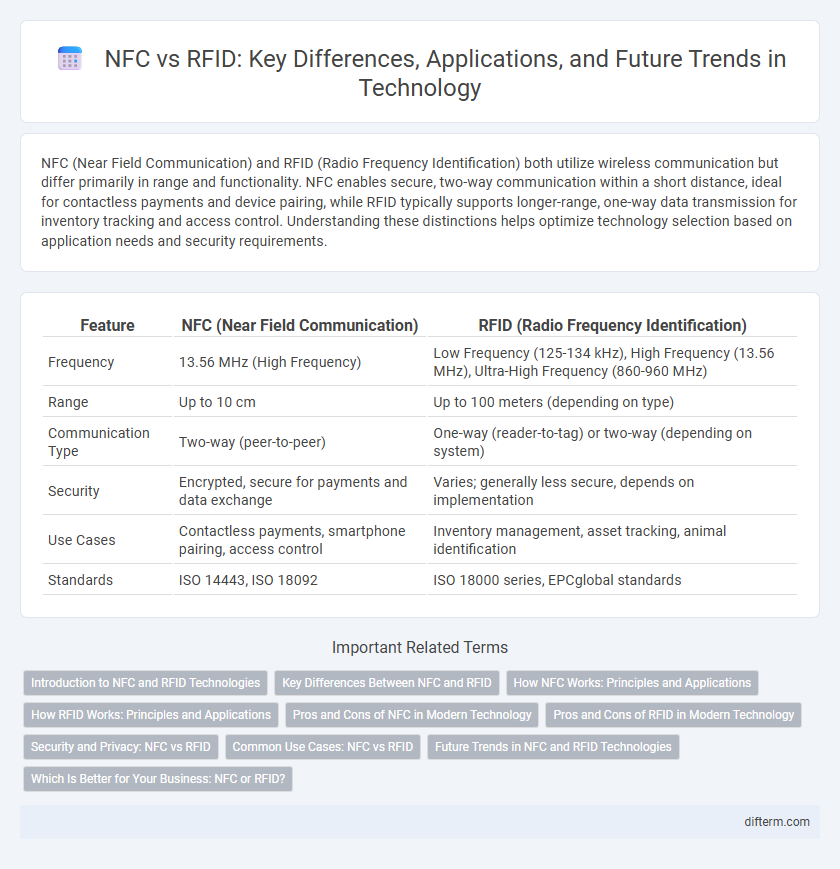NFC (Near Field Communication) and RFID (Radio Frequency Identification) both utilize wireless communication but differ primarily in range and functionality. NFC enables secure, two-way communication within a short distance, ideal for contactless payments and device pairing, while RFID typically supports longer-range, one-way data transmission for inventory tracking and access control. Understanding these distinctions helps optimize technology selection based on application needs and security requirements.
Table of Comparison
| Feature | NFC (Near Field Communication) | RFID (Radio Frequency Identification) |
|---|---|---|
| Frequency | 13.56 MHz (High Frequency) | Low Frequency (125-134 kHz), High Frequency (13.56 MHz), Ultra-High Frequency (860-960 MHz) |
| Range | Up to 10 cm | Up to 100 meters (depending on type) |
| Communication Type | Two-way (peer-to-peer) | One-way (reader-to-tag) or two-way (depending on system) |
| Security | Encrypted, secure for payments and data exchange | Varies; generally less secure, depends on implementation |
| Use Cases | Contactless payments, smartphone pairing, access control | Inventory management, asset tracking, animal identification |
| Standards | ISO 14443, ISO 18092 | ISO 18000 series, EPCglobal standards |
Introduction to NFC and RFID Technologies
NFC (Near Field Communication) and RFID (Radio Frequency Identification) are wireless communication technologies used for data exchange between devices. NFC operates at a frequency of 13.56 MHz and enables secure, short-range communication typically within 4 cm, making it ideal for contactless payments and access control. RFID systems vary in frequency bands--low, high, and ultra-high frequencies--and support longer read ranges up to several meters, commonly applied in inventory tracking and supply chain management.
Key Differences Between NFC and RFID
NFC (Near Field Communication) operates within a short range of about 4 centimeters, enabling secure, two-way communication ideal for mobile payments and access control, while RFID (Radio Frequency Identification) supports longer ranges up to several meters, primarily for inventory management and asset tracking. NFC uses higher frequency (13.56 MHz) and supports active and passive modes, whereas RFID encompasses low, high, and ultra-high frequency bands, with passive tags requiring no power source and active tags containing batteries for extended range. Security features in NFC are more advanced due to encryption protocols tailored for contactless transactions, contrasting with RFID's broader, less secure applications focused on identification and data capture.
How NFC Works: Principles and Applications
NFC (Near Field Communication) operates through electromagnetic induction between two loop antennas, enabling data exchange within a short range of about 4 cm. This technology facilitates secure contactless communication, predominantly used for mobile payments, access control, and data sharing between smartphones. NFC protocols build upon RFID standards but emphasize bidirectional communication, making it ideal for interactive applications such as ticketing and smart posters.
How RFID Works: Principles and Applications
RFID operates by utilizing electromagnetic fields to automatically identify and track tags attached to objects, which consist of a microchip and an antenna. The RFID reader emits radio waves that activate the tag, enabling data exchange between the tag and the reader without direct line of sight. This technology finds extensive applications in supply chain management, inventory control, access security, and contactless payments, providing efficient and real-time data capture.
Pros and Cons of NFC in Modern Technology
NFC offers seamless, short-range communication with strong security protocols, making it ideal for contactless payments and secure access control in modern technology. Its limited range of approximately 4 centimeters enhances privacy but restricts data transfer distances compared to RFID's broader range. However, NFC devices generally consume less power and support two-way communication, while their relatively slower data transfer rate and compatibility issues with some existing RFID systems present limitations.
Pros and Cons of RFID in Modern Technology
RFID technology offers rapid, contactless data transmission and high durability in harsh environments, making it ideal for inventory management and asset tracking. However, RFID systems face limitations such as higher implementation costs and potential security vulnerabilities due to unauthorized scanning risks. Despite these challenges, RFID remains crucial in supply chain automation and smart retail applications where real-time identification is essential.
Security and Privacy: NFC vs RFID
NFC utilizes short-range communication typically within 4 cm, significantly reducing the risk of unauthorized interception compared to RFID's longer range, which can extend several meters. NFC incorporates secure elements and encryption standards, enhancing data protection and preventing eavesdropping, while passive RFID often lacks robust security features. Privacy concerns with RFID arise from its ability to scan tags without user knowledge, whereas NFC requires close proximity and intentional interaction, offering greater user control over data exchange.
Common Use Cases: NFC vs RFID
NFC technology is commonly used for contactless payments, secure access control, and data exchange between smartphones, offering short-range communication within a few centimeters. RFID is widely implemented in inventory management, asset tracking, and supply chain logistics due to its longer reading distance and ability to scan multiple tags simultaneously. Both technologies enhance automation and efficiency but differ in range, data transfer speed, and typical application environments.
Future Trends in NFC and RFID Technologies
NFC and RFID technologies are rapidly evolving with future trends emphasizing enhanced security protocols and increased integration with IoT devices for seamless data exchange. Advances in miniaturization and energy efficiency are enabling more widespread adoption in smart cities, healthcare, and supply chain management. Emerging standards aim to improve interoperability and expand real-time tracking capabilities, driving innovation in contactless payments and asset management solutions.
Which Is Better for Your Business: NFC or RFID?
NFC (Near Field Communication) offers secure, short-range communication ideal for contactless payments and access control, while RFID (Radio Frequency Identification) provides longer range tracking suited for inventory management and asset tracking. Businesses prioritizing high security and user interaction benefit from NFC, whereas companies needing broad tracking coverage and bulk item scanning prefer RFID. Evaluating specific operational needs and environmental factors determines the optimal technology choice for efficiency and cost-effectiveness.
NFC vs RFID Infographic

 difterm.com
difterm.com